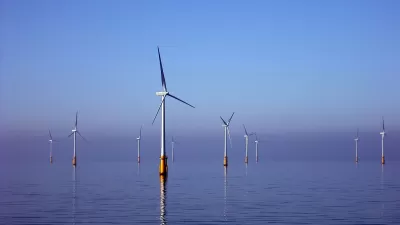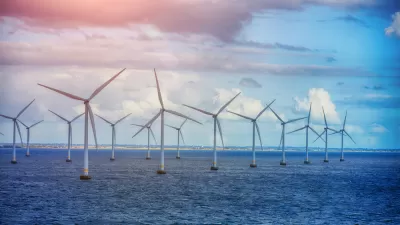Environmentalists decry the proposed wind farm as harmful to the fragile ecosystem of the Central California coast.

"A plan by private corporations to float up to eight wind power generators less than three miles offshore has run headlong into efforts to designate a vast area of ocean off the Central Coast as a Chumash Heritage National Marine Sanctuary," reports Louis Sahagún. The proposed sanctuary "would extend offshore more than 70 miles in some areas, and include shipwrecks, kelp forests, underwater canyons and a seamount that rises more than a mile above the ocean floor."
"However, applications have been submitted by Cierco Corp. and Ideol USA to the State Lands Commission for leases to install up to eight floating wind turbines in state waters about 2 ½ miles offshore, and within the boundaries of the Chumash marine sanctuary." An additional federal plan would add 380 turbines northwest of Morro Bay. "The plan would also create 44,000 jobs and help speed up our conversion from fossil fuels to renewables."
But the Northern Chumash and conservationists oppose the plan, citing potential damage to the delicate, "uniquely Californian" local ecosystem. "Building a network of floating turbines that are tethered to the seafloor and connected to one another and the mainland with electric cables is an affront to preservation, [members of the Northern Chumash Tribe] say."
The Chumash aren't alone in their opposition to the project. "Critics of the wind turbine proposal include tribal leaders, the California Coastal Commission, NOAA, the Pacific Coast Federation of Fishermen’s Assns., the Alliance of Communities for Sustainable Fisheries and a coalition of environmental groups led by Defenders of Wildlife, the Monterey Bay Aquarium, the Surfrider Foundation, Sierra Club California, the Natural Resources Defense Council, the Center for Biological Diversity and the Environmental Defense Center."
FULL STORY: A Chumash tribe and conservationists fight offshore wind turbines

Planetizen Federal Action Tracker
A weekly monitor of how Trump’s orders and actions are impacting planners and planning in America.

Chicago’s Ghost Rails
Just beneath the surface of the modern city lie the remnants of its expansive early 20th-century streetcar system.

San Antonio and Austin are Fusing Into one Massive Megaregion
The region spanning the two central Texas cities is growing fast, posing challenges for local infrastructure and water supplies.

Since Zion's Shuttles Went Electric “The Smog is Gone”
Visitors to Zion National Park can enjoy the canyon via the nation’s first fully electric park shuttle system.

Trump Distributing DOT Safety Funds at 1/10 Rate of Biden
Funds for Safe Streets and other transportation safety and equity programs are being held up by administrative reviews and conflicts with the Trump administration’s priorities.

German Cities Subsidize Taxis for Women Amid Wave of Violence
Free or low-cost taxi rides can help women navigate cities more safely, but critics say the programs don't address the root causes of violence against women.
Urban Design for Planners 1: Software Tools
This six-course series explores essential urban design concepts using open source software and equips planners with the tools they need to participate fully in the urban design process.
Planning for Universal Design
Learn the tools for implementing Universal Design in planning regulations.
planning NEXT
Appalachian Highlands Housing Partners
Mpact (founded as Rail~Volution)
City of Camden Redevelopment Agency
City of Astoria
City of Portland
City of Laramie




























